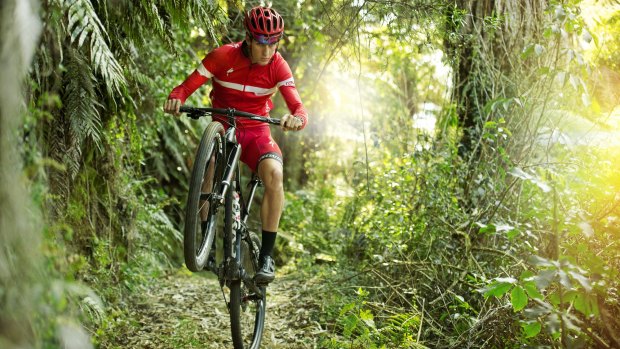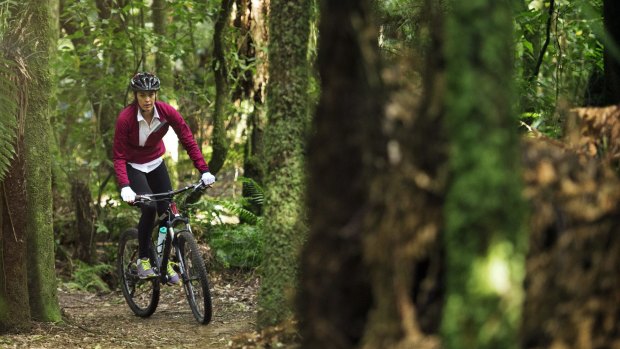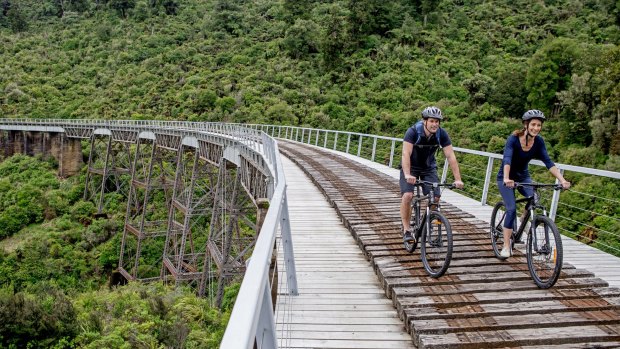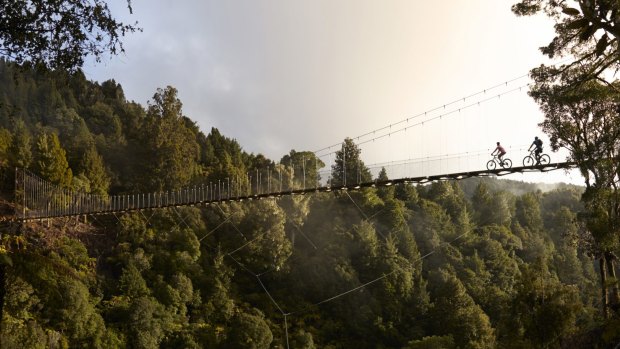This was published 8 years ago
Biking the Timber Trail, the latest ride in New Zealand's Cycle Trail

The Timber Trail.
There comes a time on almost every bike ride when you wish you'd done more training. Usually, however, it comes later than this.
I'm three kilometres in, and my legs are burning. That's three kilometres of an 87-kilometre ride. That means there are 84 kilometres still to ride, including eight slow climbs, seven rapid descents, 35 bridge crossings, some dense forest, some open plains, some rocky single-track riding, some sedate, flat pedalling, a few lunch breaks, more than a few snack breaks, and one overnight stay at a hunters lodge. What I'm saying is, I really need to get going.
It's a mental challenge as much as anything. This is the beginning of the Timber Trail, one of the newest and most enjoyable bike tracks in New Zealand, a stand-alone journey that is also part of the New Zealand Cycle Trail, a network of 23 rides throughout the length of the country.

Through an ancient forest. The Timber Trail - New ZealandCredit: Mickey Ross
This should be a fairly leisurely cycle. There's some single-track mountain-biking to do here, as we climb through the forest around Mount Pureora in the centre of the North Island, but the whole track is rated between grades two and three: easy to intermediate. So it really shouldn't be a problem for riders of most abilities.
It's just the start that gets you. The first section of the Timber Trail is a 13-kilometre climb to the top of Mount Pureora. It's by far the longest and most difficult ascent of the whole trail, so while it's great to get something like that out of the way early, it's also a baptism of fire for the cyclist who maybe didn't train quite as much as he could have.
My guide for this two-day ride is Ted Webb, a Canadian who now calls nearby Lake Taupo home, and runs the cycle touring company Tread Routes. Ted is thin and wiry, the perfect build for a cyclist, and he wears a permanent look of smiling ease even as I pant and heave and force my bike up the dirt track behind him.

The Timber Trail Ruapehu, Tongariro National Park.
This section we're tackling, while difficult, is also stunningly beautiful. The trailhead brings us straight into dense old-growth forest, the gnarled, moss-covered trunks of rimu trees sharing space with cabbage trees and native totara. Overhead you can hear a chorus of calls from kereru and kaka birds. There's a stream burbling nearby. It would all be so idyllic if it weren't for the climb I know I'm faced with.
The Timber Trail is named as such because this area used to be a major logging centre. While protests – some of the first anti-logging protests in the world, in fact – saved the area around Mount Pureora from getting the chop, much of the second half of the trail was loggers' territory, with the bike path now following the old railroad track that was used to cart out the timber.
All along the 87 kilometres of track that stretches from Mount Pureora to the town of Ongarue, signposts take riders through the three histories of the area: the Maori history, as three tribes called this area home; the ecological history; and the modern history. They're fascinating insights into the area, and they also serve as a great excuse to stop pedalling for a while and catch your breath.

The Timber Trail Lake Taupo Fraser Clements.
That's what I've been doing at frequent intervals, but each time Ted is mounted up after a few minutes, looking bright and fresh and ready to continue. The 13 kilometres to the top of Mount Pureora take us only about an hour and a half, but it still feels like an achievement to make it to the summit. From here, it's almost literally all downhill. There are a few small peaks and what Ted calls "clutch climbs", but the bulk of the next 74 kilometres will be spent on either flat ground or on a white-knuckle ride in a downward direction.
That's what greets us at the top of Mount Pureora: a long, winding section of downhill riding, an exercise in concentration and nerve as we pelt down the dirt track and rip through the corners. Now this is my kind of cycling. The forest is a blur as I hang onto the brakes and watch the kilometres fly by.
CLUTCH CLIMBS
Compared to that first ascent, the rest of the day is a breeze. It's 41 kilometres all up today, but much of that flashes past in rapid descent. On one stretch we meet a couple of German backpackers, cyclists on road bikes who've elected to do the ride in reverse, from Ongarue to Mount Pureora, and who seem to be regretting it.
"Are we near the top?" one pleads, walking his bike up the hill. I don't have the heart to tell him that no, you're not even close.
Pretty soon, however, I'm feeling his pain. At the 41-kilometre mark Ted and I exit the Timber Trail and make our way along a new path towards our lodging for the night, an old hunters cabin called Blackfern that has seen a huge surge in patronage since the Timber Trail was completed in 2015.
There's only one small problem: to get to the lodge, you have to finish the day with a steep three-kilometre climb. Nightmare. The owners of the lodge, with typically wry Kiwi humour, have named the path "Sulky Road", due to the attitude of most of the riders who use it. I have to admit, I'm walking my bike up the last few hundred metres. It's a tough climb.
At the end, however, lies sweet succour in the form of a cold beer, a hot dinner, and probably the most comfortable bed I've ever slept in.
Day two. Today is a longer ride, 55 kilometres, but it's also far easier than day one. No long climbs. No narrow single-track. Just a day of following the old loggers' railway down towards Ongarue.
Today we'll also be crossing the bulk of the trail's eight suspension bridges, including the longest, the 141-metre Maramataha Bridge, which whisks riders over a steep forested ravine that's also traversed by the old wooden rail bridge. We'll be passing through some of the old logging villages, ghost towns that are now little more than rusted skeletons of old homes, with sleepers and bits of railway track littering the bushes nearby. This is a day for appreciating the charm of the area, for taking in the views, for listening to the birdsong and enjoying the breeze on your face.
There are short climbs and then long sections of downhill. We spot an old turning circle where locomotives were spun around. There's the spiral where trains used to work their way up a steep hill.
Eventually the old rail trail ends and we emerge in rich green farmland, on an undulating track that soon joins with the main road and takes us to the little town of Ongarue, and the end of our journey. Ted, as smiley and unruffled as ever, tackles these last few kilometres with ease, while I slog it out behind him, silently congratulating myself on a task complete, and swearing that next time – next time – I'll do a little more training.
TRIP NOTES
MORE INFORMATION
newzealand.com; treadroutes.co.nz
GETTING THERE
Air New Zealand flies from the east coast of Australia to Rotorua, via Auckland. See airnewzealand.com.au. Budget Rent A Car has vehicles available for the one-hour drive to Taupo. See budget.com.au.
STAYING THERE
For your base in Taupo, Millenium Hotel and Resort has spacious rooms right on the lakefront. Go to milleniumhotels.co.nz/milleniumtaupo
SEE + DO
Ted Webb's Tread Routes offers several options for those keen to ride the Timber Trail, from fully guided itineraries to a shuttle service to basic bike hire. See treadroutes.co.nz.
The writer travelled as a guest of Tourism New Zealand
FIVE THINGS TO DO AROUND LAKE TAUPO
TAUPO BUNGY
This is New Zealand, so obviously there's going to be the chance to jump off something high with an elastic rope tied around your legs. Taupo Bungy is a 47-metre leap into (or very close to) the Waikato River. taupobungy.co.nz
STEAMBOAT RIDE
One of the most relaxing ways to see Lake Taupo is aboard the Ernest Kemp replica steamboat, which takes passengers on a two-hour journey passing by the famous Maori rock carvings, as well as other local sights. ernestkemp.co.nz
WHITEWATER RAFTING
It's not quite as sedate as a steamboat ride, but another way to see the area around Lake Taupo is by whitewater raft, navigating more than 60 sets of rapids in the Tongariro River. The excursion includes half a day of mountain-biking. trr.co.nz
HOT POOLS
There are several thermal hot pools in the Taupo area, some of which are free, though others require paid entry. At Taupo DeBretts Hot Springs, bathers have a choice of two outdoor thermal pools set in native bushland. greatlaketaupo.com
TROUT FISHING
The Lake Taupo area has long been popular with anglers thanks to its abundance of trout-filled rivers and streams. For your best chance of landing a fish, head out with one of the area's local guides. flyfishtaupo.com
Sign up for the Traveller Deals newsletter
Get exclusive travel deals delivered straight to your inbox. Sign up now.